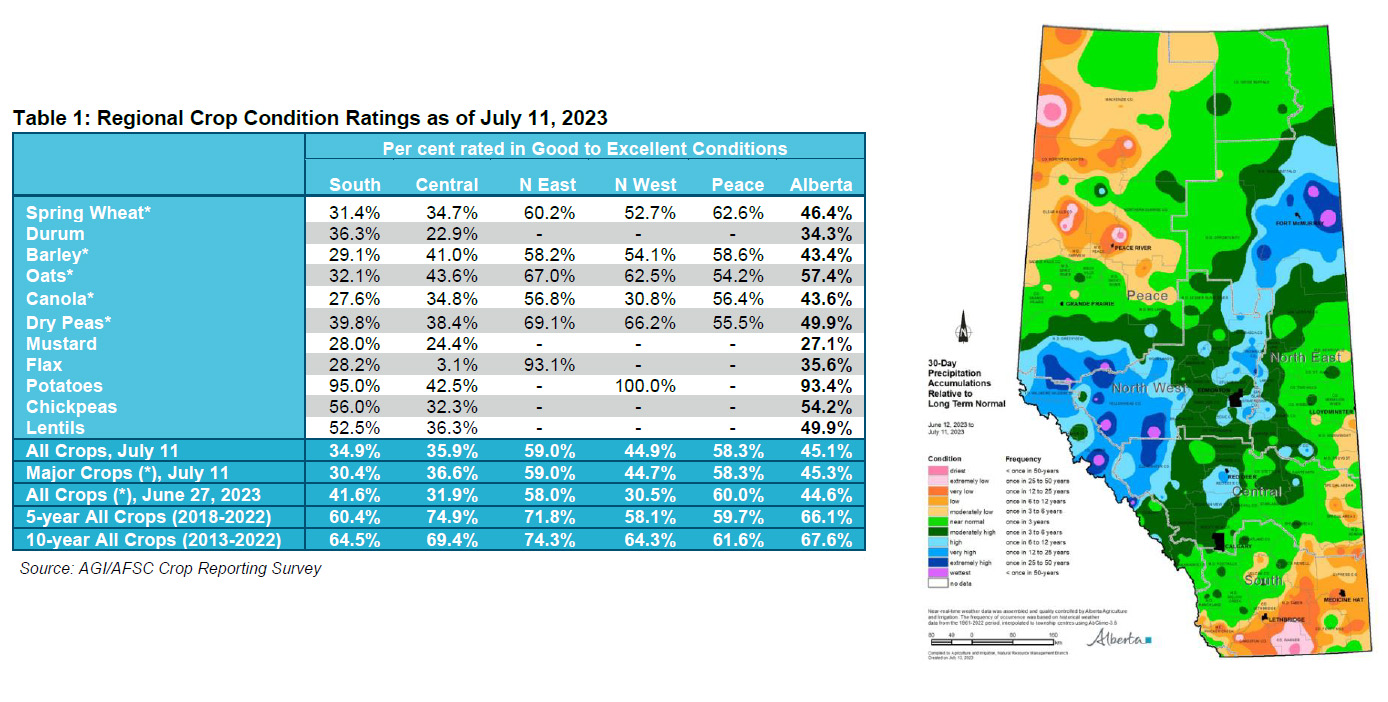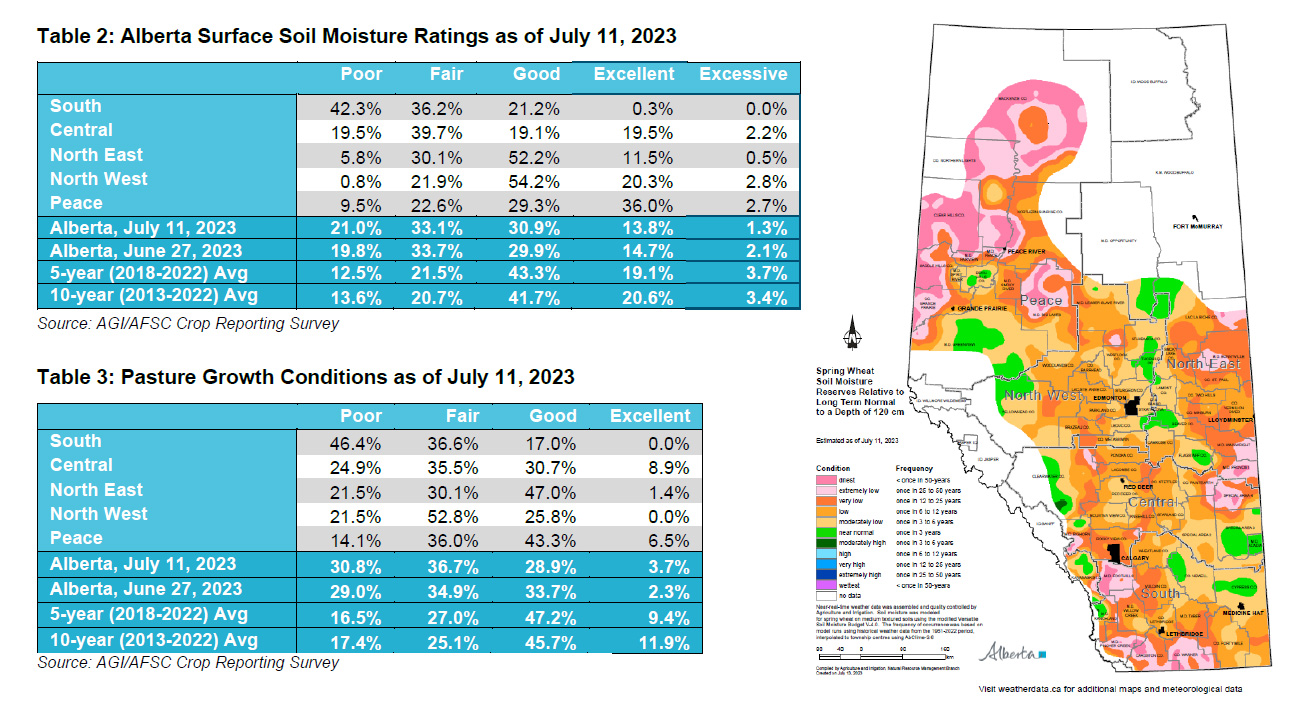Alberta Crop Report as of July 11, 2023

Crop Report, provided by the Government of Alberta Agriculture and Irrigation, as of July 11, 2023:
Over the last 30 days, parts of the province have received much-needed rains. The North West Region received 125 to over 300 mm of precipitation. Parts of the Peace received up to 200 mm of precipitation, while some areas in the North East and Central received up to 175 mm. However, many areas of these three regions, as well as the entire South Region, only received 0-50 mm of rain.
Currently, 45 per cent of all crops are rated in good to excellent condition, well below the 5 and 10-year averages of 66 and 68 per cent, respectively (see Table 1). Regionally, growing condition ratings were the highest in the North East and the Peace where conditions were 59 and 58 per cent good to excellent, respectively. Conditions are rated the lowest in the South at 35 per cent good to excellent. Compared to the 5-year average the Peace Region is only 1 per cent below average. The rest of the regions were 13 (North East) to 39 (Central) per cent below the 5-year average of crops rated in good to excellent condition.
Spring cereals are flowering across the province. 83 per cent of major broad leaf crops are flowering and 11 per cent are podding. Podding is most present in the South at 19 per cent, while the rest of the province ranges from 7-10 per cent. All crops are ahead of the 5-year average as half complete head emergence and 75 per cent flowering is average for this time of year. Provincially, the best rated crops are spring wheat (46 per cent of acres rated good to excellent), oats (57 per cent), lentils (50 per cent), potatoes (93 per cent) and chickpeas (54 per cent). The lowest rated crops are durum (34 per cent rated good to excellent), mustard (27 per cent) and flax (36 per cent). The Central, North East and North West have reported spraying for pests or disease.

Scattered showers and thunderstorms experienced across the province over the last two weeks helped stabilize many crop conditions. Surface soil moisture conditions rated 45 per cent good to excellent have been stable since the last report as well after declining from the growing season high of 57 per cent (See Table 2). Currently, surface soil moisture is rated at 21 per cent poor, 33 per cent fair, 31 per cent good, 14 per cent excellent and 1 per cent excessive. Sub-surface moisture rated good to excellent peaked earlier in the season at 47 per cent in the fourth week of May, and returned to that by the fourth week of June. Since then, conditions have dropped and stayed around 37 per cent. Currently, sub-surface soil moisture is rated (five-year average in brackets) 27 (14) per cent poor, 35 (25) per cent fair, 25 (40) per cent good, 12 (18) per cent excellent and 1 (3) per cent excessive. As seen on the map on the next page, soil moisture reserves are experiencing once-in-3-to-5-year lows to once-in-50-year lows in select areas around the South, North East, and Peace Region.

Since the second week of June, tame hay conditions have increased moderately from 31 per cent rated good to excellent to 35 per cent. As of July 11, tame hay conditions are rated at 27 per cent poor, 38 per cent fair, 29 per cent good, and 6 per cent excellent with the best ratings seen in the Peace Region. The average yield for first cut dryland hay is 0.9 tons per acre and the average yield for irrigated first cut is 2.0 tons per acre. Currently, 59 per cent of dryland first cut is complete, well ahead of the 5-year average (38 per cent). Some producers are also putting annual crops into their grazing rotations due to lack of available feed. Pasture conditions have been slightly decreasing since the third week of June and currently only 33 per cent of the pastures in Alberta are rated as good to excellent (see Table 3). Overall, 31 per cent are rated as poor, 37 per cent fair, 29 per cent good, and 4 per cent excellent.
Region Five: Peace (Fairview, Falher, Grande Prairie, Valleyview)
- Hot conditions and occasional rains have decreased crop conditions since the last report but remain the second highest rated in the province. They are currently rated at 12 per cent poor, 30 per cent fair, 51 per cent good and 7 per cent excellent.
- Rains of up to 50 mm in the last week have helped sub-surface soil moisture. The good to excellent rating increased by 3 per cent but surface soil moisture still decreased by 3 per cent. Surface soil moisture is now rated at (sub-surface soil moisture ratings shown in brackets) 10 (8) per cent poor, 23 (26) per cent fair, 29 (32) per cent good and 36 (34) per cent excellent, with 3 (0) per cent excessive.
- Dryland hay yields are averaging 1.2 tons per acre and are the highest in the province. Currently, pasture is rated at (tame hay conditions in brackets) 14 (14) per cent poor, 36 (37) per cent fair, 43 (43) per cent good, and 7 (6) per cent excellent.
To read the full report on all regions head to their website: https://open.alberta.ca/publications/2830245
Contact Us
Saddle Hills
Junction of Hwy 49 & Secondary Hwy 725
RR1, Spirit River AB
T0H 3G0
T. 780-864-3760
Fax 780-864-3904
Toll-free 1-888-864-3760
frontdesk@saddlehills.ab.ca
Sign up to our Newsletter
Stay up to date on the Saddle Hills activities, events, programs and operations by subscribing to our eNewsletters.
